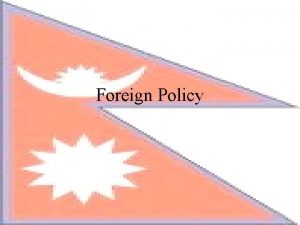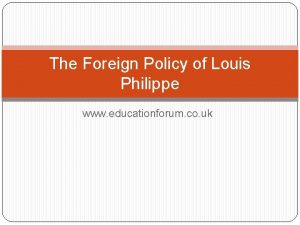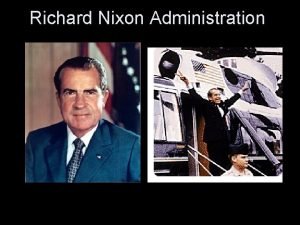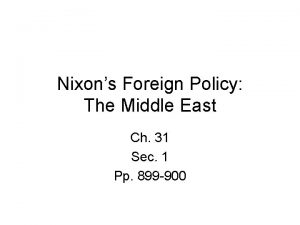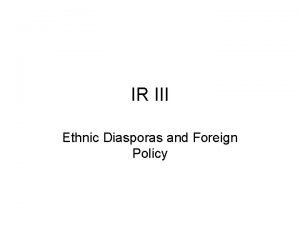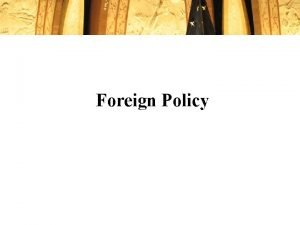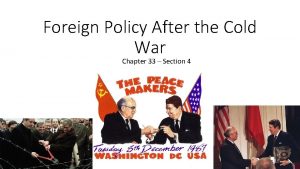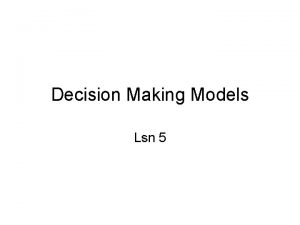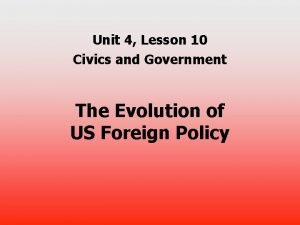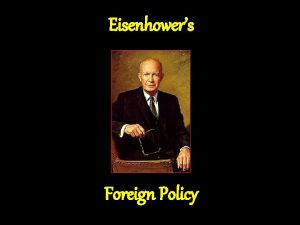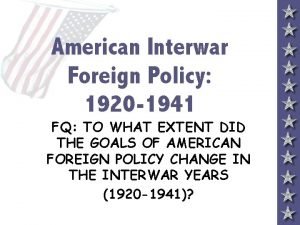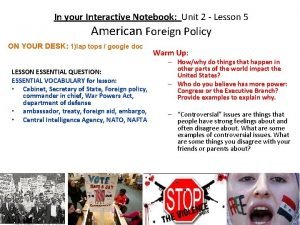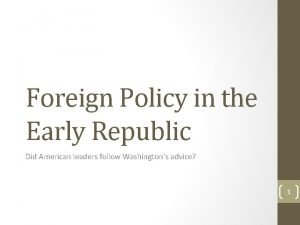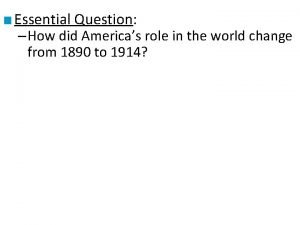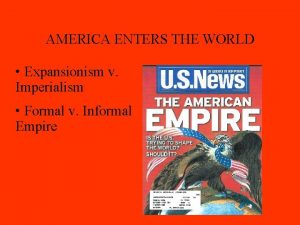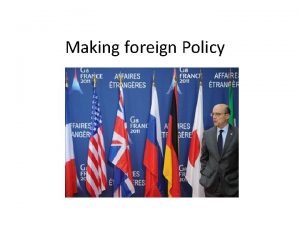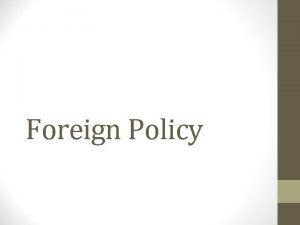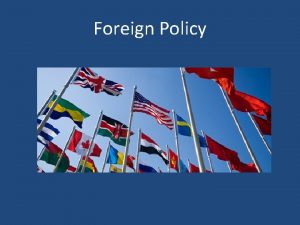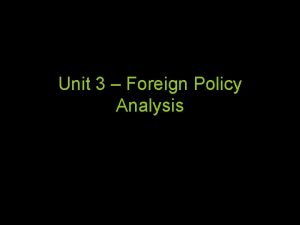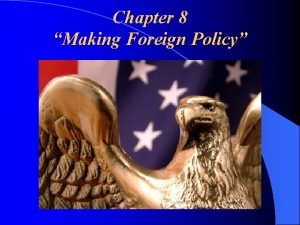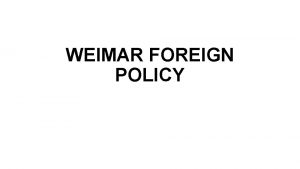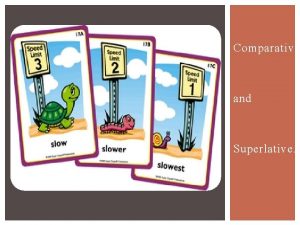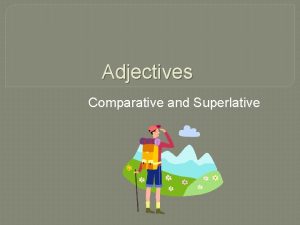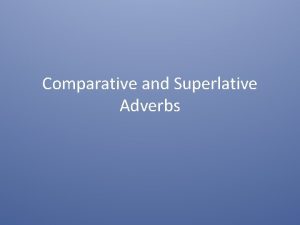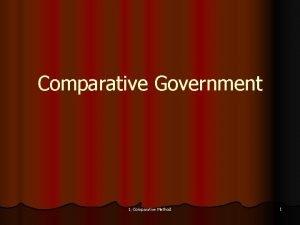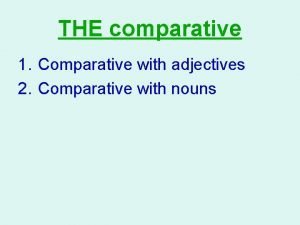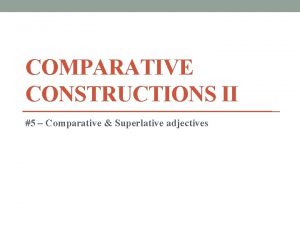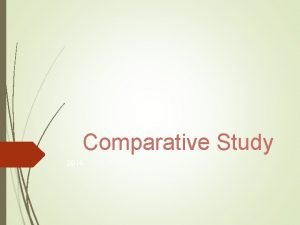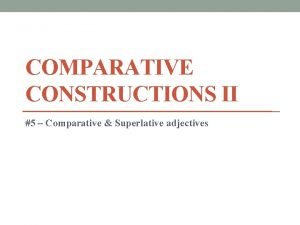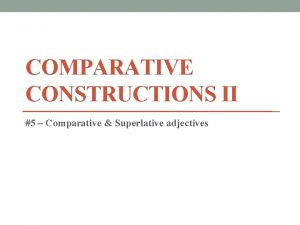Foreign Policy Analysis and Comparative Foreign Policy An



















- Slides: 19

Foreign Policy Analysis and Comparative Foreign Policy An Introduction Stephen Hoadley Associate Professor Political Studies Department 3 March 2010

What is foreign policy? Joshua Goldstein in his textbook International Relations (2005, p. 143) calls foreign policies: ‘strategies [i. e. goals and plans: s. h. ] used by governments to guide their actions in the international arena’.

Cameron (2005) p. xvii describes foreign policy as: • A consistent course of actions by a nation to deal • • • with another nation, region, or international issue…. Based on values, interests, objectives, and responses… Influenced by history, geography, culture, politics, and capacity of military, and economy… Carried out by political, diplomatic, military, economic, social and cultural instruments and institutions

Manners & Whitman (2000) p. 2 identify foreign policy as • Attempts by governments to influence or • manage events outside the state’s boundaries. Three approaches to study FPA: 1. State-centric rational-actor interest-maximising paradigm 2. Decision-process-centric or bureaucratic politics model 3. Society-centric approach including ideology, national role, ethics, and culture.

Foreign… • Directed beyond the state’s borders • Affecting the state’s interests abroad • Interacting with other governments • Or international bodies e. g. UN, WTO • But sometimes interacting with parties, gangs, corporations, or individuals

Policy Purposive decision-making By governments (or other authorities) Allocating human and material resources To initiate and implement actions To achieve specified goals

Analysis • Identification of factors of the process • Study of each factor separately, then in relation to the others • Arrangement of the factors to show a plausible sequence or causal chain • Evaluation of the outcome by comparison to goals, means, and future resources • Recommendation of better policy

Decision-making Phases: The Rational Actor Model 1. 2. 3. 4. 5. 6. Clarify goals Prioritise goals Inventory alterative routes to goals Assess consequences of each route Choose routes most likely to produce best outcomes Follow up and adjust

Foreign Policy Decision-making Process Circle See Goldstein p. 157 for one example. This one varies slightly. Also see Hoadley diagram on Cecli. 1. Monitor international and domestic threats and 2. 3. 4. 5. 6. 7. 8. opportunities Screen, sort, analyse, evaluate => intelligence Match with resources Assess probability of success Decide on policy to achieve goals Implement policy Monitor effect (seek feedback) Correct policy or initiate new policy

Eight Simplifying Assumptions 1. 2. 3. 4. 5. 6. 7. 8. Goals are clear, consistent, and legitimate Priorities are rank-able and measurable Decision-makers are honest rational maximisers without bias or self-interest Information is abundant, valid, and unambiguous Time and analysis resources are adequate Implementation is efficient and effective Costs are measurable and sustainable Adversaries have similar preferences and SOPs

But in the real world, rival domestic actors complicate decision-making • President or Prime Minister, and staffs • Secretaries (US) or ministers, and staffs • Executive administrative agencies e. g. CIA • Regulatory and watchdog agencies • Legislators, and staffs • Commercial lobby groups, MNCs, ‘MIC’ • Value lobby groups, NGOs, churches • Public opinion

And non-rational factors impact on goals and decision-making • Personal history and psychological disposition • Social construction and (mis)perception • Cognitive and affective information screening • Pressure, stress & crises reactions • Political ‘spin’, ego, bluff, damage control • Unexpected responses by foreign friends and adversaries

How decision-makers cope with complexity and uncertainty • Executive-legislative bargaining • Bureaucratic bargaining • Two-level negotiation • Organisational processes (SOPs) • Risk-aversion and Incrementalism • Satisficing rather than optimising • Deference to leader or superior • Deference to international bodies, or int’l law

The study of FPA is worthwhile because it • Bridges the artificial partition between domestic and international affairs • Spotlights significant actors and methods • Helps understand complexity and dynamics of real world governance • Clarifies concepts and measurements • Warns against biases and distortions • Aids policy assessment and prescription

Foreign Policy Analysis is on the rise in past 15 years • Until 1989 FPA was an outcast, related to domestic • • • politics, public policy and IR but respected by none. FPA snobs distanced themselves from domestic politics. But IR failed to predict collapse of USSR, which showed importance of domestic politics foreign policy Trade policy studies and two-level bargaining theory clarified the domestic-foreign link assumed by FPA. Rise of NGOs and Bush/neo-con takeover confirmed it. Now FPA is legitimized and reinvigorated. FPA is regarded as promising conceptual bridge between politics, policy studies, , and IR.

FPA also gives you a bridge to other interesting areas of study • Diplomacy and diplomatic history • Biography of key actors • Bargaining and negotiation studies • Institutional analysis • Public policy and public administration • Political parties and elections • Interest groups and public opinion • Political economy, esp. trade policy-making

Four IR Theories Compared States. Interests, power & survival Rivalry Cooperation REALISM LIBERAL INTERNATIONALISM Societies. FOREIGN People, groups, POLICY institutions, ideas ANALYSIS and values Compare with 10 CONSTRUCTIVISM

An offshoot of FPA is Comparative Foreign Policy (CFP) • A lively sub-field of FPA is Comparative Foreign Policy (CFP) studies • CFP attempts to find variables that cause different foreign policies e. g. war, cooperation, liberalism – – – Size, wealth and power => small state theory Geography => geopolitics Culture => clash of civilizations Economics => neo-Marxism, structuralism Executive and legislative institutions => decisiveness Electoral systems => coherence and consistency • CFP’s greatest success is ‘democratic peace theory’ • It also hopes to transcend focus on the US model and give more attention to the emerging European model.

CFP shows FPA of EU members is distinct from the US model • The decision to join the EU imposes – – New compliance obligations and constraints New human and material resource burdens New consultation and decision complications New opportunities for extended influence • In each issue states must decide whether to pursue • • interests bilaterally, multilaterally, via the EU, or all The EU ideal and aquis will socialise actors over time, deepen ‘habit’ and SOPs Sovereignty gives way to cooperation and community
 Foreign policy analysis
Foreign policy analysis So here you are too foreign for home
So here you are too foreign for home 1790 foreign policy
1790 foreign policy Foreign policy of louis philippe
Foreign policy of louis philippe What was thomas jefferson foreign policy
What was thomas jefferson foreign policy Nixons foreign policy
Nixons foreign policy Nixons foreign policy
Nixons foreign policy Actors in foreign policy
Actors in foreign policy Definition of foreign policy by scholars
Definition of foreign policy by scholars Chapter 33 section 4 foreign policy after the cold war
Chapter 33 section 4 foreign policy after the cold war Rational actor model cuban missile crisis
Rational actor model cuban missile crisis Unit 4 lesson 10 american foreign policy
Unit 4 lesson 10 american foreign policy Truman foreign policy vs eisenhower
Truman foreign policy vs eisenhower Interwar foreign policy
Interwar foreign policy Lesson 5 american foreign policy
Lesson 5 american foreign policy Hitler's foreign policy timeline
Hitler's foreign policy timeline Foreign policy in the early republic
Foreign policy in the early republic Foreign policy imperialism
Foreign policy imperialism Foreign policy imperialism
Foreign policy imperialism Andrew johnson foreign policy
Andrew johnson foreign policy
